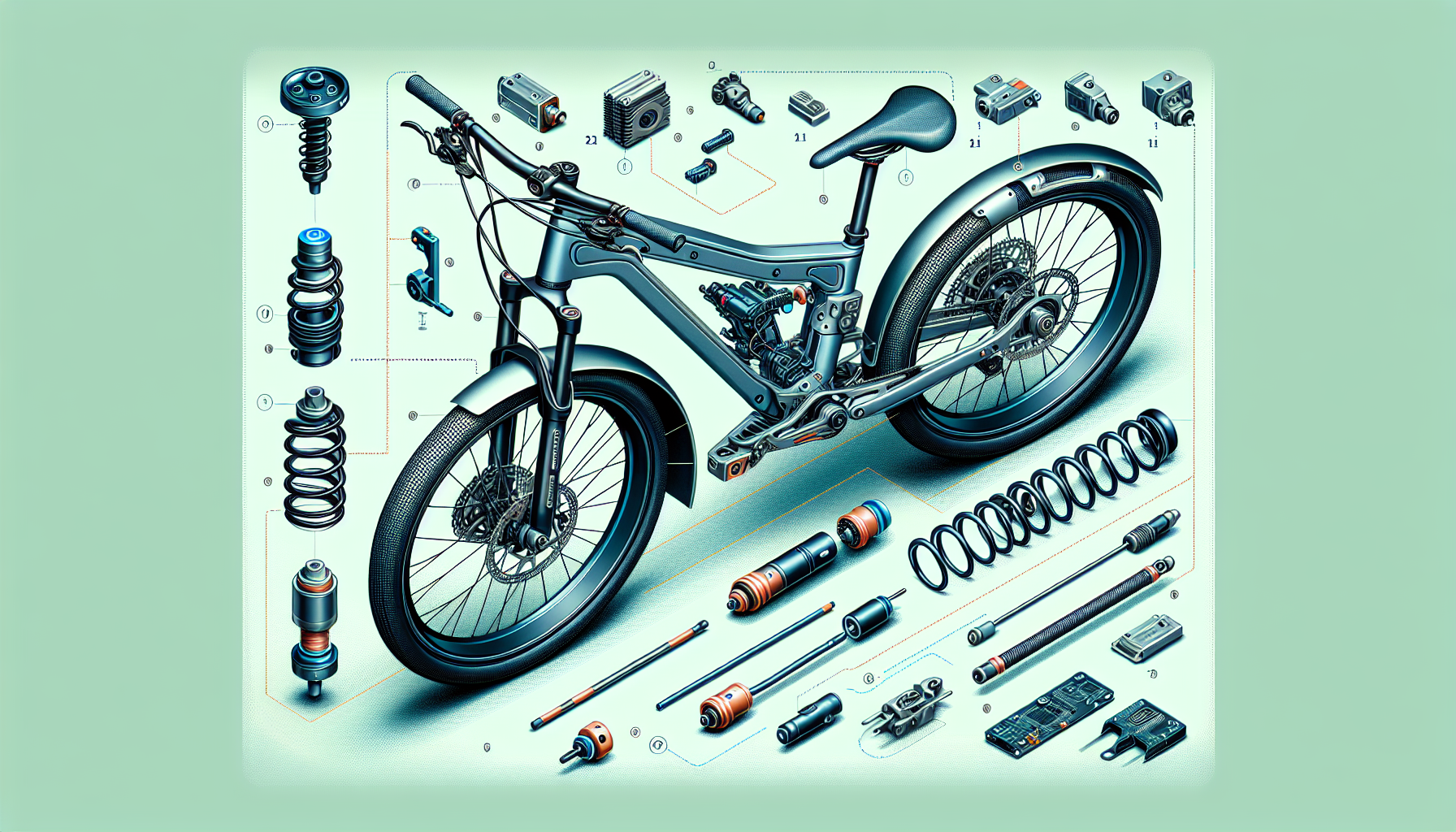Are you wondering if e-bikes come equipped with suspension systems? Well, you’re in the right place! This article aims to provide you with a clear answer to the question on every e-bike enthusiast’s mind. Get ready to discover whether the thrilling world of e-biking includes the extra comfort and enhanced riding experience that suspension systems bring to the table. So let’s jump right in and explore this ever-popular topic!
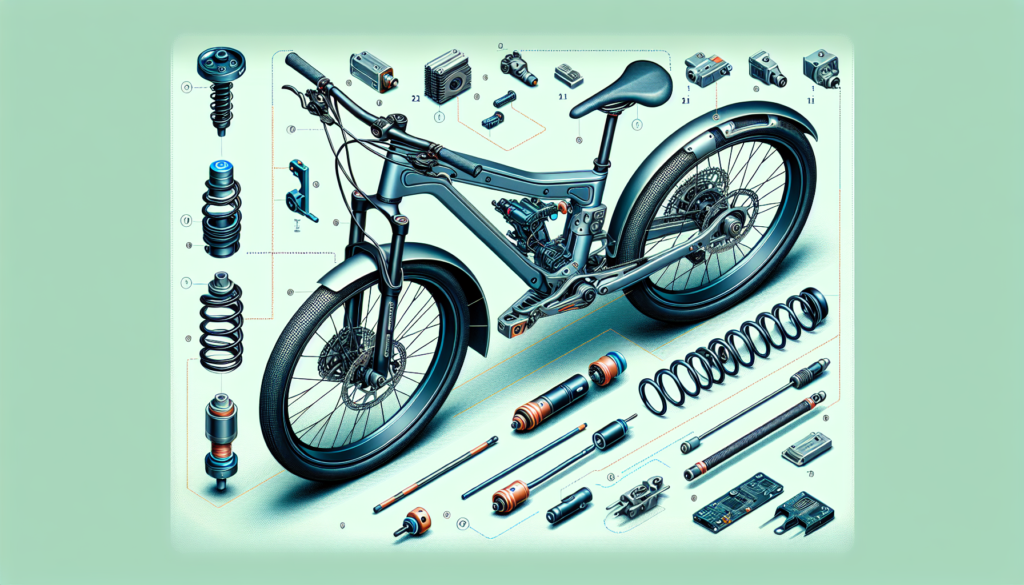
Overview of E-bikes
Definition of e-bikes
E-bikes, short for electric bikes, are bicycles that are equipped with an electric motor to assist with pedaling. These motorized bicycles have gained popularity in recent years due to their ability to provide an extra boost when climbing hills or riding against strong winds. E-bikes come in various styles and models, catering to different riding preferences and purposes.
Key features of e-bikes
E-bikes come with several key features that set them apart from conventional bicycles. One of the most prominent features is the electric motor, which helps to augment the rider’s pedaling power. This motor is usually powered by a rechargeable battery and can be activated or deactivated as per the rider’s preference. Additionally, e-bikes often come with an integrated display that allows the rider to monitor the battery level, speed, and distance traveled. Some models also offer features like built-in lights, fenders, and racks for added convenience.
Types of e-bikes
There are several types of e-bikes available in the market, each designed for specific purposes and riding styles. Some common types include:
Electric Mountain Bikes (eMTBs): These e-bikes are specifically designed for off-road adventures and feature rugged frames, wide tires, and suspension systems to tackle challenging terrains.
Urban/City E-bikes: Urban e-bikes are ideal for commuting and navigating city streets. They often have a more streamlined design, with features like lights, fenders, and a comfortable riding position.
Hybrid E-bikes: Hybrid e-bikes combine the features of road bikes and mountain bikes, making them versatile enough for both city commutes and light off-road trails.
Comfort E-bikes: As the name suggests, comfort e-bikes prioritize a comfortable ride and often come with wide, cushioned seats and ergonomic handlebars.
Specialized E-bikes: These e-bikes cater to specific niches, such as adventure riding, cargo transportation, fat tire biking, or long-distance touring.
Importance of Suspension Systems
Enhanced Comfort
One of the primary reasons why suspension systems are important in e-bikes is enhanced comfort. When riding on uneven terrain or encountering bumps and potholes, a suspension system helps to absorb the shocks and vibrations, providing a smoother and more comfortable ride. Without suspension, the rider may experience jolts and discomfort, especially during longer rides or off-road adventures.
Improved Handling and Control
Suspension systems also play a crucial role in improving handling and control. By absorbing the impact of obstacles on the road, suspension allows the tires to maintain better contact with the ground, resulting in improved traction and stability. This, in turn, enhances the rider’s ability to maneuver the e-bike, especially in challenging conditions like wet or slippery surfaces.
Reduced Fatigue and Impact on Body
Riding an e-bike without suspension for an extended period can lead to increased fatigue and impact on the body. The shocks and vibrations transmitted through the bike can cause strain on the wrists, arms, and back, leading to discomfort and potential injuries. Suspension systems help to minimize these impacts, reducing the strain on the rider’s body and allowing for longer, more enjoyable rides.
Better Traction and Stability
Suspension systems contribute to better traction and stability, especially when riding on rough or uneven terrain. The ability of the suspension to adjust to changes in the ground surface helps the tires maintain a consistent grip, minimizing the risk of skidding or losing control. This is particularly crucial for off-road or mountain biking, where traction and stability are essential for a safe and enjoyable ride.
Types of Suspension Systems
Front Suspension
Front suspension, also known as “hardtail,” is a suspension system that only incorporates suspension in the front fork of the e-bike. This type of suspension is commonly found on urban e-bikes, hybrid e-bikes, and some mountain bikes designed for less aggressive trails. Front suspension helps to absorb shocks from the front wheel, providing a more comfortable ride and improved handling on uneven roads.
Full Suspension
Full suspension, as the name suggests, refers to e-bikes equipped with suspension systems in both the front fork and the rear shock. This type of suspension is typically found on mountain bikes and electric mountain bikes (eMTBs) designed for more challenging off-road trails. Full suspension offers enhanced comfort, improved handling, and better control on rough terrains by absorbing shocks from both the front and rear wheels.
Hardtail vs. Full Suspension
The choice between hardtail and full suspension ultimately depends on the rider’s intended use and terrain. Hardtail e-bikes are generally lighter and more efficient for riding on smooth paved roads or light off-road trails. They also tend to be more cost-effective compared to full suspension e-bikes. On the other hand, full suspension e-bikes provide superior comfort and control on more technical and demanding terrains, making them a better choice for avid off-road enthusiasts or eMTB riders.
Factors to Consider
Riding Style and Terrain
Your riding style and the type of terrain you frequent are key factors to consider when choosing an e-bike suspension system. If you primarily ride on smooth, paved roads or well-maintained trails, a front suspension or hardtail e-bike may be sufficient to provide the desired level of comfort and control. However, if you frequently encounter rough, off-road trails with roots, rocks, and bumps, a full suspension e-bike would offer the necessary support and cushioning for a smooth ride.
Budget and Cost
Another crucial factor to consider is your budget and the cost of the e-bike. E-bikes with full suspension tend to be more expensive than those with front suspension or hardtails. If cost is a determining factor, you may need to prioritize your riding needs and find a balance between the desired level of suspension and your budget.
Maintenance and Durability
Suspension systems, particularly full suspension setups, require regular maintenance to ensure optimal performance. If you are not comfortable or willing to invest the time and effort in maintaining your e-bike’s suspension system, opting for a simpler front suspension or hardtail may be a more suitable choice. Additionally, consider the durability of the suspension components and evaluate if they can withstand the type of riding you intend to do.
Weight and Portability
The weight and portability of an e-bike with suspension should also be taken into account. Full suspension e-bikes tend to be heavier due to the additional components involved. If you need to transport your e-bike frequently or if weight is a concern, a hardtail or front suspension e-bike may be a more practical option.
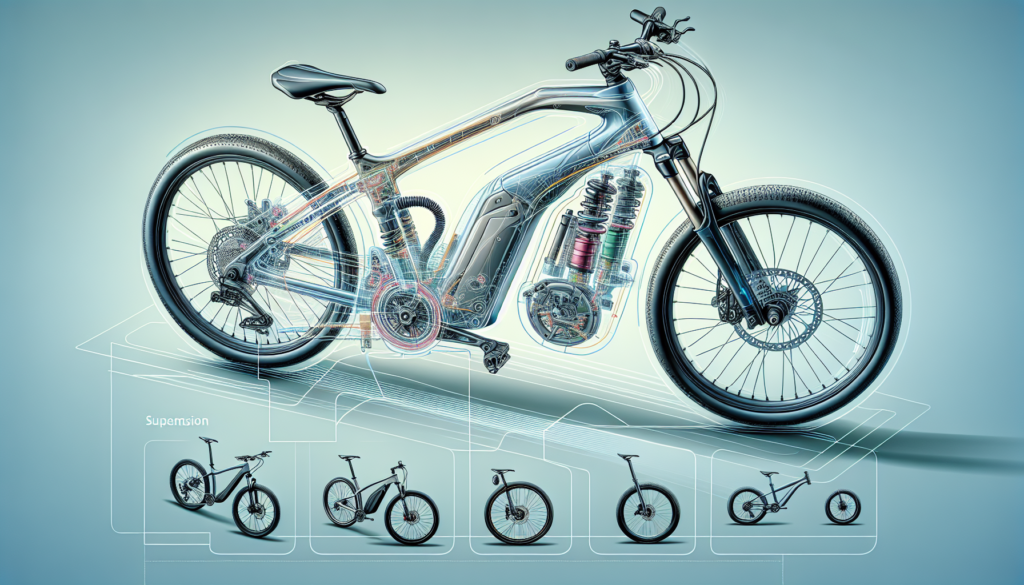
Electric Mountain Bikes (eMTBs)
Significance of Suspension in eMTBs
Suspension systems play a crucial role in eMTBs due to the rugged terrains and challenging conditions they are designed to tackle. eMTBs often have to navigate steep climbs, rocky descents, and uneven trails, requiring a suspension system to absorb the impacts and offer a smooth ride. Without suspension, the rider would feel every bump and jolt, making the experience uncomfortable and potentially hazardous.
Trail/Enduro eMTBs with Full Suspension
For riders who enjoy aggressive off-road adventures, trail or enduro eMTBs equipped with full suspension are the ideal choice. These e-bikes feature robust frames, wide tires, and both front and rear suspension systems to conquer challenging terrains. Full suspension ensures optimal comfort, improved handling, and enhanced control, allowing riders to seamlessly tackle various obstacles encountered on the trails.
Hardtail eMTBs with Front Suspension
While full suspension eMTBs are popular for their ability to handle advanced trails, hardtail eMTBs with front suspension also have their merits. Hardtails are lighter, more efficient in pedaling, and often less costly than full suspension eMTBs. They are suitable for less technical trails or riders who prefer a more traditional mountain biking experience. Front suspension helps absorb shocks from the front wheel, providing ample cushioning and control.
Factors for Selecting eMTB Suspension
When selecting an eMTB suspension system, factors such as the intensity of your off-road adventures, the terrain you plan to conquer, and your skill level should be taken into consideration. Full suspension eMTBs are favored by experienced riders seeking maximum performance, comfort, and control on challenging trails. Hardtail eMTBs are a popular choice for riders who prioritize efficiency, cost-effectiveness, and lighter weight on less technical trails.
Urban/City E-bikes
Importance of Suspension in Urban E-bikes
While urban riding may not involve rugged terrains like mountain biking, suspension systems still hold importance for urban e-bikes. In cities, roads and infrastructure can be uneven, with potholes and bumps that can cause discomfort and impact the rider’s control. Suspension in urban e-bikes helps to absorb these shocks, providing a smoother and more enjoyable riding experience.
Types of Suspension for Urban E-bikes
Urban e-bikes typically utilize front suspension or hardtail setups. As these bikes are primarily designed for commuting and navigating city streets, front suspension provides adequate comfort and control to handle the uneven surfaces encountered on urban rides. The suspension system helps to minimize the vibrations and impacts from potholes and rough roads, ensuring a more comfortable ride in the urban environment.
Criteria for Choosing Urban E-bike Suspension
When selecting suspension for urban e-bikes, consider factors such as the quality of roads in your city, the distance of your commute, and your personal preference for comfort. If your city has well-maintained roads and your rides are relatively short, a front suspension e-bike may suffice. However, if you encounter rougher roads or have a longer commute, a full suspension e-bike or a model with wider tires can provide the extra comfort needed for a smooth urban ride.
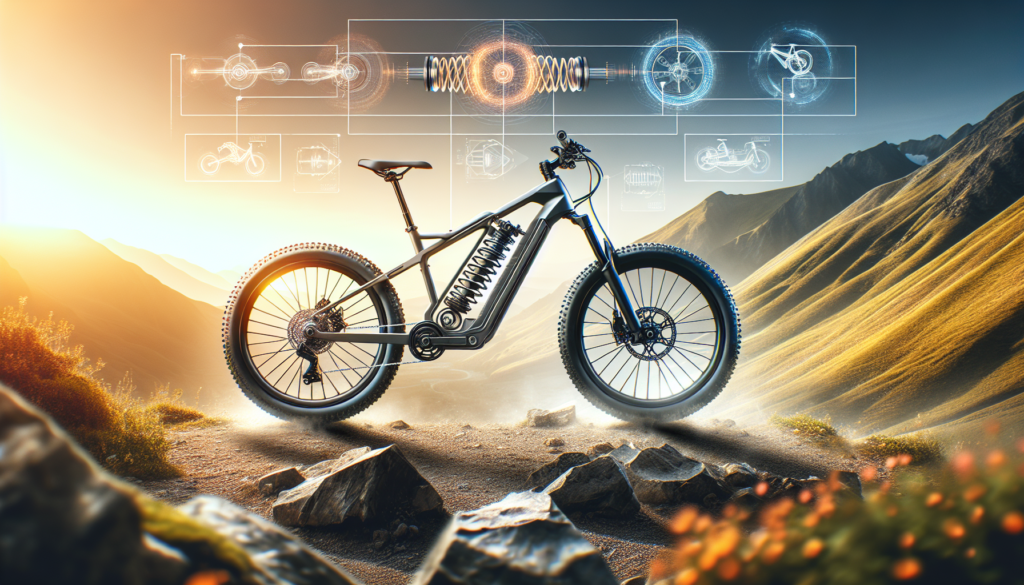
Hybrid E-bikes
Significance of Suspension in Hybrid E-bikes
Hybrid e-bikes are designed to bridge the gap between road cycling and mountain biking. As such, suspension systems play a significant role in enhancing the versatility and adaptability of these e-bikes. Hybrid e-bikes are meant to handle various terrains, from paved roads to gravel trails and light off-road tracks. Suspension allows riders to tackle rougher surfaces with more comfort and control, providing a smoother riding experience.
Front Suspension vs. No Suspension for Hybrids
Hybrid e-bikes commonly come in two variations: those equipped with front suspension and those without any suspension at all. The choice between the two depends on the type of terrain you anticipate riding on. If your hybrid e-bike will primarily be used for city commuting or smooth, paved roads, a model without suspension can be more efficient and cost-effective. However, if you plan to venture onto gravel or light off-road trails, a hybrid e-bike with front suspension will offer added comfort and improved handling.
Choosing Suspension for Hybrid E-bikes
When selecting a suspension system for hybrid e-bikes, consider factors such as the type of terrains you plan to ride, the distances you wish to cover, and your desired level of comfort. Front suspension is suitable for riders who frequently encounter uneven surfaces but still prioritize efficiency for city commuting. Alternatively, if you anticipate more off-road adventures, a hybrid e-bike with full suspension or wider tires may offer the necessary support and cushioning for a smoother ride.
Comfort E-bikes
Role of Suspension in Comfort E-bikes
Comfort e-bikes are designed with the primary objective of providing a comfortable riding experience. Suspension systems play a vital role in achieving this goal by minimizing the impact of shocks and vibrations on the rider’s body. By absorbing the terrain’s irregularities, suspension helps to reduce fatigue, enhance overall comfort, and allow for longer and more enjoyable rides.
Reclining Seat Suspension
In addition to front suspension or full suspension setups, some comfort e-bikes may also feature a suspension system for the reclining seat. This suspension allows the rider’s seat to absorb shocks and vibrations, further enhancing comfort and reducing strain on the lower back and hips. Reclining seat suspension is particularly beneficial for individuals with back pain or those seeking a leisurely and relaxed riding experience.
Other Suspension Features for Comfort E-bikes
Comfort e-bikes may also incorporate other suspension features to maximize comfort. These can include suspension seat posts, which provide additional cushioning for the rider’s seat, and suspension handlebars, which absorb vibrations and shocks from the handlebar area. These additional suspension components enhance the overall comfort of the ride, making comfort e-bikes an excellent choice for recreational rides and long-distance cycling.
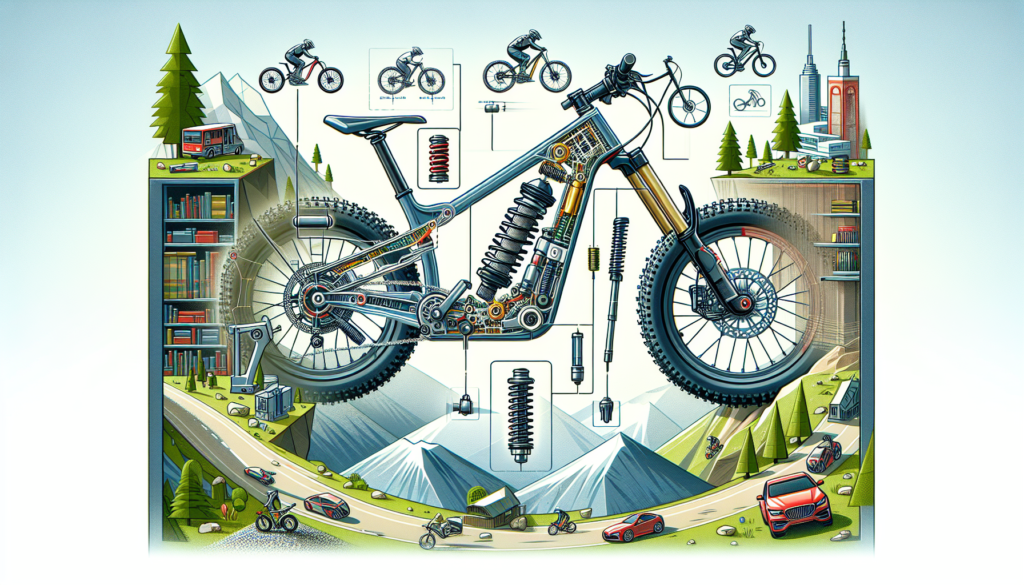
Specialized E-bikes
Off-Road/Adventure E-bikes
Off-road or adventure e-bikes are specifically designed to handle the rigors of rough terrains and provide exhilarating experiences for adventurous riders. These specialized e-bikes are equipped with robust suspension systems, typically full suspension, to tackle challenging trails and extreme conditions. The suspension allows riders to traverse obstacles, drops, and jumps more confidently, maintaining control and minimizing discomfort.
Cargo E-bikes
Cargo e-bikes are designed to carry heavy loads, whether it’s groceries, equipment, or even children. Suspension systems are an essential component of cargo e-bikes, as they help distribute the weight evenly and provide stability. These e-bikes often have both front and rear suspension to ensure a smooth and balanced ride, even with a significant load on board.
Fat Tire E-bikes
Fat tire e-bikes are characterized by their wider-than-normal tires, which offer enhanced traction and stability on various terrains, including snow, sand, and mud. These specialized e-bikes often come with front suspension or full suspension setups to complement the wide tires and provide extra shock absorption. The suspension allows fat tire e-bike riders to safely navigate through challenging terrains, regardless of the surface conditions.
Touring E-bikes
Touring e-bikes are designed for long-distance rides, whether it’s a multi-day trip or a cross-country adventure. These e-bikes prioritize comfort and durability, making suspension systems a crucial component. Depending on the terrain and personal preferences, touring e-bikes may feature front suspension or full suspension setups. The suspension helps absorb shocks and vibrations during extended rides, reducing fatigue and allowing riders to maintain a steady, comfortable pace.
Suspension Components and Technology
Forks
Forks are a primary component of e-bike suspension systems, located at the front of the bike. They consist of two tubes, one sliding inside the other, with an internal spring mechanism that allows the fork to compress and rebound. Forks can have adjustable features, such as rebound damping, which controls how quickly the fork returns to its extended position after compression. Higher-end e-bikes may feature air forks, which allow riders to customize the fork’s performance by adjusting the air pressure.
Rear Shocks
Full suspension e-bikes are equipped with rear shocks, which work in conjunction with the front fork to provide a balanced suspension system. Rear shocks come in various designs and can be coil-sprung or air-sprung. Coil-sprung shocks tend to offer a simpler setup and durability, while air-sprung shocks provide more adjustability and lighter weight. Rear shocks often have features like rebound damping and compression damping, allowing riders to fine-tune the suspension’s performance based on their preferences and riding style.
Suspension Settings and Adjustments
Many e-bikes with suspension systems offer adjustable settings and adjustments to customize the suspension’s performance. These settings can include adjusting the preload, rebound damping, and compression damping. Preload adjustments allow riders to fine-tune the suspension’s response based on their weight, while rebound damping controls the speed at which the suspension returns after compression. Compression damping helps regulate the amount of force required to compress the suspension. By making these adjustments, riders can optimize their e-bike’s suspension for different terrains, riding styles, and personal preferences.
In conclusion, suspension systems are an essential aspect of e-bikes, providing enhanced comfort, improved handling, reduced fatigue, and better traction and stability. The type of suspension, whether it be front suspension, full suspension, or a hardtail setup, should be chosen based on the rider’s intended use, terrain, budget, and desired level of maintenance. Different types of e-bikes, such as eMTBs, urban e-bikes, hybrid e-bikes, comfort e-bikes, and specialized e-bikes, benefit from tailored suspension systems to optimize their performance and deliver the best riding experience. Understanding the role of suspension components and technologies, such as forks, rear shocks, and customizable settings, further empowers riders to select the most suitable e-bike suspension for their needs. With the right suspension system in place, you can enjoy the benefits of e-biking with added comfort, control, and confidence.

